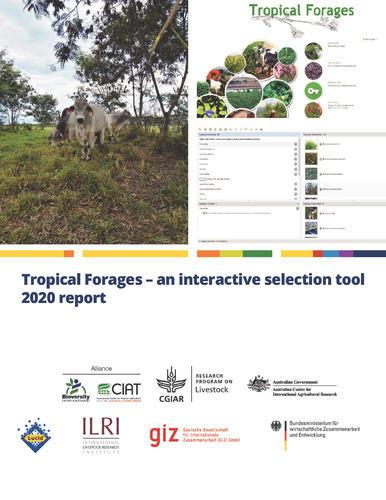Tropical Forages: an interactive selection tool

The tool aims to promote adoption of a large suite of grasses and legumes to be used as livestock feeds and for ecosystems services e.g. to help curb greenhouse gas emissions and reverse land degradation in the tropics and subtropics.
This tool was developed as a means of capturing the expertise of experienced, often retired, forage specialists from across the globe and presenting it in a structured way that can guide a new generation of researchers, advisors, development specialists and farmers to make informed choices about species and genotypes for particular environments and farming systems.
Tropical Forages has two major components. The first provides a concise but wide range of information on tropical forage species in factsheets, including morphology, distribution, agronomic management, nutritional value and productive potential. These outline not only the benefits of these plants, but also threats they might pose if not appropriately selected or managed. The second is a selection tool, which allows users to find the kinds of forage plants that are likely to satisfy the needs of farmers in a particular context, i.e. plants that are adapted to the target environment and slot neatly into farming systems in the area.
In what context is this tool useful?
This tool is useful in a context where users need to:
- Identify a list of forage species suitable for particular combinations of climates, soils, production systems and management,
- Access and download comprehensive information on these species with details of adaptation, uses and management of species, cultivars and elite accessions,
- Access information on potential risks (mostly weediness or toxicity) associated with the use of species, and
- View images of the various forages and their uses.
Results achieved
A total of 217 users answered an online user survey that was conducted from August to September 2021, to gather feedback on the user experience and usefulness of the tool. Majority of respondents (75%) were from the education and research sectors. About 10 per cent were extension agents and about 8 per cent were either from seed producing companies/distributors or farmers.
The information gathered from the tool was used primarily for education purposes (35%), followed by research (31.8%), and for farmer training and/or extension services (23%). About 10 per cent of respondents said they use the tool for farm improvement or simply for obtaining knowledge.
For instance, since several years, researchers and students from the Universidad del Salvador (USAL) have been using the Tropical Forages Selection tool in a course called ‘Forrajicultura’ (Agriculture of forages). Using the knowledge gathered from the tool, they are developing extension materials for the cattle farmers of the Misiones province in Argentina, recommending forage species that are best adapted to the current and potential new conditions, such as high humidity and extreme drought.
Variations on this method
Originally launched in 2005 and updated in 2020, the second edition is a comprehensive update of the tool, which incorporates redesign and rewrite of all fact sheets, additional species and a recalibration of the selection tool. The extensive photo library has also been updated. A key feature of the new edition is an update of the underlying technology platform to enable its distribution on mobile devices and the web without any additional software or plug-ins.
The revised selection tool now also includes desirability options according to the level of environmental concern of the included forages, ranging from no or minimal risk, over some risk, to some species whose forage benefit is outweighed by the environmental risk.
Regarding technical features, the website has a new design, incorporates automatic Google translation and is fully compatible with any internet browser currently available. In order to reach more people in the global tropics including those with poor bandwidth, the selection tool can be downloaded for offline use and a mobile application was developed, which is accessible through both Google Play and Apple’s App Store.

